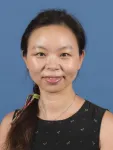(Press-News.org) Honeybees are famously finicky when it comes to being studied. Research instruments and conditions and even unfamiliar smells can disrupt a colony’s behavior. Now, a joint research team from the Mobile Robotic Systems Group in EPFL’s School of Engineering and School of Computer and Communication Sciences and the Hiveopolis project at Austria’s University of Graz have developed a robotic system that can be unobtrusively built into the frame of a standard honeybee hive.
Composed of an array of thermal sensors and actuators, the system measures and modulates honeybee behavior through localized temperature variations.
“Many rules of bee society – from collective and individual interactions to raising a healthy brood – are regulated by temperature, so we leveraged that for this study,” explains EPFL PhD student Rafael Barmak, first author on a paper on the system recently published in Science Robotics. “The thermal sensors create a snapshot of the bees’ collective behavior, while the actuators allow us to influence their movement by modulating thermal fields.”
“Previous studies on the thermal behavior of honeybees in winter have relied on observing the bees or manipulating the outside temperature,” adds Martin Stefanec of the University of Graz. “Our robotic system enables us to change the temperature from within the cluster, emulating the heating behavior of core bees there, and allowing us to study how the winter cluster actively regulates its temperature.”
A ‘biohybrid superorganism’ to mitigate colony collapse
Bee colonies are challenging to study in winter since they are sensitive to cold, and opening their hives risks harming them in addition to influencing their behavior. But thanks to the researchers’ biocompatible robotic system, they were able to study three experimental hives, located at the Artificial Life Lab at the University of Graz, during winter and to control them remotely from EPFL. Inside the device, a central processor coordinated the sensors, sent commands to the actuators, and transmitted data to the scientists, demonstrating that the system could be used to study bees with no intrusion – or even cameras – required.
Mobile Robotic Systems Group head Francesco Mondada explains that one of the most important aspects of the system – which he calls a ‘biohybrid superorganism’ for its combination of robotics with a colony of individuals acting as a living entity – is its ability to simultaneously observe and influence bee behavior.
“By gathering data on the bees’ position and creating warmer areas in the hive, we were able to encourage them to move around in ways they would never normally do in nature during the winter, when they tend to huddle together to conserve energy. This gives us the possibility to act on behalf of a colony, for example by directing it toward a food source, or discouraging it from dividing into too-small groups, which can threaten its survival.”
The scientists were able to prolong the survival of a colony following the death of its queen by distributing heat energy via the actuators. The system’s ability to mitigate colony collapse could have implications for bee survivability, which has become a growing environmental and food security concern as the pollinators’ global populations have declined.
Never-before-seen behaviors
In addition to its potential to support colonies, the system has shed light on honeybee behaviors that have never been observed, opening new avenues in biological research.
“The local thermal stimuli produced by our system revealed previously unreported dynamics that are generating exciting new questions and hypotheses,” says EPFL postdoctoral researcher and corresponding author Rob Mills. “For example, currently, no model can explain why we were able to encourage the bees to cross some cold temperature ‘valleys’ within the hive.”
The researchers now plan to use the system to study bees in summertime, which is a critical period for raising young. In parallel, the Mobile Robotic Systems Group is exploring systems using vibrational pathways to interact with honeybees.
“The biological acceptance aspect of this work is critical: the fact that the bees accepted the integration of electronics into the hive gives our device great potential for different scientific or agricultural applications,” says Mondada.
Funding
This work was supported by the EU H2020 FET project HIVEOPOLIS (no. 824069), coordinated by Thomas Schmickl, and by the Field of Excellence COLIBRI (Complexity of Life in basic Research and Innovation) at the University of Graz.
END
Robotic system offers hidden window into collective bee behavior
EPFL researchers have developed a temperature-modulating robotic system that can be seamlessly integrated into notoriously sensitive honeybee hives, providing both a never-before-seen view of honeybee behavior and a means to influence it
2023-03-23
ELSE PRESS RELEASES FROM THIS DATE:
Octapharma USA grant supports PANS/PANDAS education event at NHIA Conference March 27 in Washington, D.C.
2023-03-23
PARAMUS, N.J. (March 23, 2023) – Octapharma USA has provided a grant for an educational program on pediatric acute-onset neuropsychiatric syndrome (PANS) and PANDAS, a subset of PANS associated with strep, to be held during the National Home Infusion Association (NHIA) Annual Conference scheduled for March 25 – 27 in Washington, D.C.
Octapharma is enrolling more patients and sites for its phase 3 multicenter superiority study comparing the effectiveness of panzyga® (immune globulin intravenous, human - ifas) 10% liquid preparation versus placebo ...
Scientists warn of rise in potentially fatal bacterial infection due to global warming
2023-03-23
Continued warming of the climate would see a rise in the number and spread of potentially fatal infections caused by bacteria found along parts of the coast of the United States.
Vibrio vulnificus bacteria grow in warm shallow coastal waters and can infect a cut or insect bite during contact with seawater. A new study led by the UK’s University of East Anglia (UEA) shows that the number of V. vulnificus infections along the East Coast of the US, a global hotspot for such infections, has gone ...
UTSA researchers exploit vulnerabilities of smart device microphones and voice assistants
2023-03-23
(SAN ANTONIO) MARCH 23, 2023 - Guenevere Chen, an associate professor in the UTSA Department of Electrical and Computer Engineering, recently published a paper on USENIX Security 2023 that demonstrates a novel inaudible voice trojan attack to exploit vulnerabilities of smart device microphones and voice assistants — like Siri, Google Assistant, Alexa or Amazon’s Echo and Microsoft Cortana — and provide defense mechanisms for users.
The researchers developed Near-Ultrasound Inaudible Trojan, or NUIT (French for “nighttime”) to study how hackers exploit speakers and ...
Without this, plants cannot respond to temperature
2023-03-23
UC Riverside scientists have significantly advanced the race to control plant responses to temperature on a rapidly warming planet. Key to this breakthrough is miRNA, a molecule nearly 200,000 times smaller than the width of a human hair.
With moderate increases in temperature, plants grow taller to avoid hotter ground and get fresher air. A landmark study published in the journal Nature Communications demonstrates that microRNA or miRNA is required for this growth. The study also identifies which miRNA molecules — out of more than 100 possibilities — are the essential ones.
“We found that without miRNA plants will not grow, even ...
Use of melatonin linked to decreased self-harm in young people
2023-03-23
Medical sleep treatment may reduce self-harm in young people with anxiety and depression, an observational study from Karolinska Institutet in Sweden suggests. The risk of self-harm increased in the months preceding melatonin prescription and decreased thereafter, especially in girls. The study is published in The Journal of Child Psychology and Psychiatry.
Melatonin is a hormone that controls the sleep-wake cycle and is the most commonly prescribed drug for sleep disturbances in children and adolescents in Sweden. Melatonin use has dramatically increased in recent years, and it is available over the counter in Sweden since 2020.
“Given the established link between sleep ...
Pressure-based control enables tunable singlet fission materials for efficient photoconversion
2023-03-23
Applying hydrostatic pressure as an external stimulus, Tokyo Tech and Keio University researchers demonstrate a new way to regulate singlet fission (SF), a process in which two electrons are generated from a single photon, in chromophores, opening doors to the design of SF-based materials with enhanced (photo)energy conversion. Their method overrides the strict requirements that limit the molecular design of such materials by realizing an alternative control strategy.
Singlet fission (SF) is a process in which ...
New wood-based technology removes 80% of dye pollutants in wastewater
2023-03-23
Researchers at Chalmers University of Technology, Sweden, have developed a new method that can easily purify contaminated water using a cellulose-based material. This discovery could have implications for countries with poor water treatment technologies and combat the widespread problem of toxic dye discharge from the textile industry.
Clean water is a prerequisite for our health and living environment, but far from a given for everyone. According to the World Health Organization, WHO, there are currently over two billion people living with limited or no access to clean water.
This global challenge ...
Optical switching at record speeds opens door for ultrafast, light-based electronics and computers
2023-03-23
Imagine a home computer operating 1 million times faster than the most expensive hardware on the market. Now, imagine that level of computing power as the industry standard. University of Arizona researchers hope to pave the way for that reality using light-based optical computing, a marked improvement from the semiconductor-based transistors that currently run the world.
"Semiconductor-based transistors are in all of the electronics that we use today," said Mohammed Hassan, assistant professor of physics and optical sciences. "They're part of every industry – from kids' toys to ...
Depressed, and aging fast
2023-03-23
Older adults with depression are actually aging faster than their peers, UConn Center on Aging researchers report.
“These patients show evidence of accelerated biological aging, and poor physical and brain health,” which are the main drivers of this association, says Breno Diniz, a UConn School of Medicine geriatric psychiatrist and author of the study, which appears in Nature Mental Health on March 22.
Diniz and colleagues from several other institutions looked at 426 people with late-in-life ...
Study finds “considerable uncertainty” around effectiveness and safety of analgesics for low back pain
2023-03-23
Despite nearly 60 years of research, there is still a lack of high certainty evidence on the effectiveness and safety of commonly used painkillers (analgesics) for short bouts of low back pain, finds an analysis of the evidence published by The BMJ.
The researchers say that until higher quality trials comparing analgesics with each other are published, “clinicians and patients are advised to take a cautious approach to manage acute non-specific low back pain with analgesic medicines.”
Analgesics such as paracetamol, ibuprofen, and codeine ...
LAST 30 PRESS RELEASES:
ASH 2025: Antibody therapy eradicates traces of multiple myeloma in preliminary trial
ASH 2025: AI uncovers how DNA architecture failures trigger blood cancer
ASH 2025: New study shows that patients can safely receive stem cell transplants from mismatched, unrelated donors
Protective regimen allows successful stem cell transplant even without close genetic match between donor and recipient
Continuous and fixed-duration treatments result in similar outcomes for CLL
Measurable residual disease shows strong potential as an early indicator of survival in patients with acute myeloid leukemia
Chemotherapy and radiation are comparable as pre-transplant conditioning for patients with b-acute lymphoblastic leukemia who have no measurable residual disease
Roughly one-third of families with children being treated for leukemia struggle to pay living expenses
Quality improvement project results in increased screening and treatment for iron deficiency in pregnancy
IV iron improves survival, increases hemoglobin in hospitalized patients with iron-deficiency anemia and an acute infection
Black patients with acute myeloid leukemia are younger at diagnosis and experience poorer survival outcomes than White patients
Emergency departments fall short on delivering timely treatment for sickle cell pain
Study shows no clear evidence of harm from hydroxyurea use during pregnancy
Long-term outlook is positive for most after hematopoietic cell transplant for sickle cell disease
Study offers real-world data on commercial implementation of gene therapies for sickle cell disease and beta thalassemia
Early results suggest exa-cel gene therapy works well in children
NTIDE: Disability employment holds steady after data hiatus
Social lives of viruses affect antiviral resistance
Dose of psilocybin, dash of rabies point to treatment for depression
Helping health care providers navigate social, political, and legal barriers to patient care
Barrow Neurological Institute, University of Calgary study urges “major change” to migraine treatment in Emergency Departments
Using smartphones to improve disaster search and rescue
Robust new photocatalyst paves the way for cleaner hydrogen peroxide production and greener chemical manufacturing
Ultrafast material captures toxic PFAS at record speed and capacity
Plant phenolic acids supercharge old antibiotics against multidrug resistant E. coli
UNC-Chapel Hill study shows AI can dramatically speed up digitizing natural history collections
OYE Therapeutics closes $5M convertible note round, advancing toward clinical development
Membrane ‘neighborhood’ helps transporter protein regulate cell signaling
Naval aviator turned NPS doctoral student earns national recognition for applied quantum research
Astronomers watch stars explode in real time through new images
[Press-News.org] Robotic system offers hidden window into collective bee behaviorEPFL researchers have developed a temperature-modulating robotic system that can be seamlessly integrated into notoriously sensitive honeybee hives, providing both a never-before-seen view of honeybee behavior and a means to influence it





